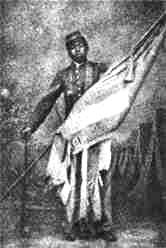The Extraordinary Story of William Carney
Carney and the rest of the 54th Massachusetts trained for several months in early 1863 and then reported to Hilton Head, South Carolina. After a brief first engagement, they faced their first real test, in an attack on Fort Wagner, on Morris Island, on July 18. The fort was heavily defended, with both cannons and sharpshooters. Nonetheless, the order came for the 54th Massachusetts to lead the way in storming the fort. They did just that, advancing through a withering storm of enemy fire. Carney was advancing when he saw the flagholder get shot and drop the flag. Carney rushed ahead and grabbed the flag before it could reach the ground, letting go of his gun so he could grasp the flag with both hands. (During the Civil War, especially, it was an honor to carry the flag of the Union or the Confederacy. But such men often paid a dear price, since they had to use both hands to carry the large flagpole and so couldn't carry a gun with which to defend themselves. And since the flag was such a powerful symbol of both sides' causes, the flag-bearer was often a popular target for soldiers with guns.) Carney carried the flag alongside other members of his regiment, who continued to advance even though they probably knew that their attack had little chance of succeeding. Carney, even though he was shot in one leg, made it through the enemy's defenses and entered the fort. He planted the flagpole atop the high wall and proudly displayed the colors of the United States Flag.
William Carney survived his multiple wounds and later became the first Black recipient of the Congressional Medal of Honor. |
|
Social Studies for Kids
copyright 2002–2025
David White

 Amid all the chaos and carnage, Carney was alone for a time, wincing at the pain in his leg but determined to keep the flag flying high. When he noticed a group of soldiers, moving toward him, he picked the flag up and waved it, intending to inspire them to continue the fight. These men were Southern soldiers, who opened fire on Carney and the flag. The quick-footed and quick-witted Carney realized that he had no protection but the flag but that the flag had no protection but him. He ran down the high embankment surrounding the fort, with a hail of bullets chasing him. He held the flag high as he ran and so was a target for enemy soldiers everywhere he went. He was shot in the chest, the right arm, and the right leg (where he had been shot earlier). He stumbled on, determined to keep the flag from falling to the ground and falling into enemy hands. Another bullet grazed his hand, but Carney soldiered on. Amazingly, he made it back to the Union forces, where he was promptly ushered into the medical tent. He had achieved both of his goals.
Amid all the chaos and carnage, Carney was alone for a time, wincing at the pain in his leg but determined to keep the flag flying high. When he noticed a group of soldiers, moving toward him, he picked the flag up and waved it, intending to inspire them to continue the fight. These men were Southern soldiers, who opened fire on Carney and the flag. The quick-footed and quick-witted Carney realized that he had no protection but the flag but that the flag had no protection but him. He ran down the high embankment surrounding the fort, with a hail of bullets chasing him. He held the flag high as he ran and so was a target for enemy soldiers everywhere he went. He was shot in the chest, the right arm, and the right leg (where he had been shot earlier). He stumbled on, determined to keep the flag from falling to the ground and falling into enemy hands. Another bullet grazed his hand, but Carney soldiered on. Amazingly, he made it back to the Union forces, where he was promptly ushered into the medical tent. He had achieved both of his goals.
